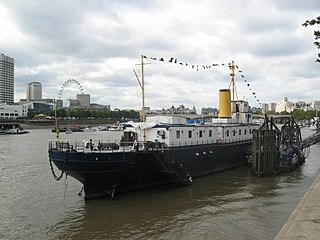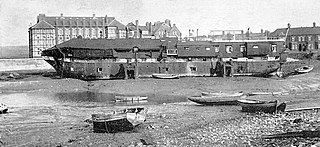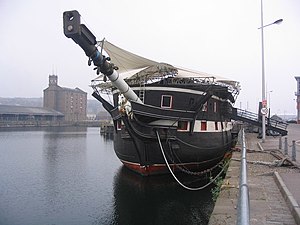
A frigate is a type of warship. In different eras, the roles and capabilities of ships classified as frigates have varied.

HMS Warrior is a 40-gun steam-powered armoured frigate built for the Royal Navy in 1859–1861. She was the name ship of the Warrior-class ironclads. Warrior and her sister ship HMS Black Prince were the first armour-plated, iron-hulled warships, and were built in response to France's launching in 1859 of the first ocean-going ironclad warship, the wooden-hulled Gloire. Warrior conducted a publicity tour of Great Britain in 1863 and spent her active career with the Channel Squadron. Obsolescent following the 1873 commissioning of the mastless and more capable HMS Devastation, she was placed in reserve in 1875, and was "paid off" – decommissioned – in 1883.

HMS Montrose was the eighth of the sixteen-ship Type 23 or Duke class of frigates, of the Royal Navy, named after the Duke of Montrose. She was laid down in November 1989 by Yarrow Shipbuilders on the Clyde, and was launched on 31 July 1992 by Edith Rifkind, wife of Malcolm Rifkind, Secretary of State for Defence. She was commissioned into service in June 1994.

HMS Plymouth was a Royal Navy Rothesay-class frigate. In 1982, Plymouth was one of the first Royal Navy ships to arrive in the South Atlantic during the Falklands War.

HMS Bronington was a Ton-class minesweeper of the Royal Navy, launched on 19 March 1953. This mahogany-hulled minesweeper was one of the last of the "wooden walls".

HMS Unicorn was an aircraft repair ship and light aircraft carrier built for the Royal Navy in the late 1930s. She was completed during World War II and provided air cover over the amphibious landing at Salerno, Italy, in September 1943. The ship was transferred to the Eastern Fleet in the Indian Ocean at the end of the year. Unicorn supported the aircraft carriers of the fleet on their operations until the British Pacific Fleet (BPF) was formed in November 1944. She was transferred to Australia in early 1945 to support the BPF's operations during Operation Iceberg, the Allied invasion of Okinawa in May. To shorten the time required to replenish the BPF's carriers, the ship was based in the Admiralty Islands and in the Philippine Islands until the Japanese surrender in August. Unicorn was decommissioned and placed in reserve when she returned to the UK in January 1946.

HMS Implacable was a 74-gun third-rate ship of the line of the Royal Navy. She was originally the French Navy's Téméraire-class ship of the line Duguay-Trouin, launched in 1800.

HMS President is a retired Flower-class Q-ship that was launched in 1918. She was renamed HMS President in 1922 and moored permanently on the Thames as a Royal Navy Reserve drill ship. In 1982 she was sold to private owners and, having changed hands twice, served as a venue for conferences and functions as well as the offices for a number of media companies. She has been moved to Chatham on the Medway in Kent since 2016, but is due to return to the capital. She had the suffix "(1918)" added to her name in order to distinguish her from HMS President, the Royal Naval Reserve base in St Katharine Docks. She is one of the last three surviving Royal Navy warships of the First World War. She is also the sole representative of the first type of purpose built anti-submarine vessels, and is the ancestor of World War II convoy escort sloops, which evolved into modern anti-submarine frigates.

HMS Trincomalee is a Royal Navy Leda-class sailing frigate built shortly after the end of the Napoleonic Wars. She is now restored as a museum ship afloat in the National Museum of the Royal Navy, Hartlepool, England.
Eleven ships of the Royal Navy have borne the name HMS Unicorn, after the mythological creature, the unicorn:

The National Museum of the Royal Navy (NMRN) is a maritime exposition and visitor attraction in Hartlepool, County Durham, Northern England. The concept of the attraction is the thematic re-creation of an 18th-century seaport, in the time of Lord Nelson, Napoleon and the Battle of Trafalgar. HMS Trincomalee, a Royal Navy frigate and Britain's oldest warship afloat is at the centre of the quay. She was built in Bombay, India in 1817. The 190th anniversary of the ship's official launch was on Friday 12 October 2007.

HMS Eaglet is a Royal Navy Reserve unit based in Liverpool. She is the main occupant of the Royal Navy Regional Headquarters in Liverpool, Merseyside. The base is also the home to a number of units, including:Royal Marines Reserve Merseyside, Naval Regional Command Northern England, Liverpool URNU, HMS Biter, HMS Charger, Sea Cadet Corps, and the Liverpool Royal Navy and Royal Marines Careers Office.

HMS President was a large frigate in the British Royal Navy (RN). She was built to replace the previous HMS President, redesignated from the heavy frigate USS President built in 1800 as the last of the original six frigates of the United States Navy under the Naval Act of 1794. The first President had been the active flagship of the U.S. Navy until captured while trying to escape the Royal Navy blockade around New York in 1815 at the end of the War of 1812, and then served in the RN until broken up in 1818. The new British President was built using her American predecessor's exact lines for reference, as a reminder to the United States of the capture of their flagship – a fact driven home by President being assigned as the flagship of the North America and West Indies Station in the western Atlantic Ocean under the command of Admiral Sir George Cockburn (1772–1853), who had directed raids throughout the Chesapeake Bay in 1813–1814 that culminated in the 1814 burning of official buildings in the American capital, Washington, D.C.

The Leda-class frigates, were a successful class of forty-seven British Royal Navy 38-gun sailing frigates constructed from 1805 to 1832. Based on a French design, the class came in five major groups, all with minor differences in their design. During their careers, they fought in the Napoleonic Wars and the War of 1812. Forty-five of the 47 were eventually scrapped; two still exist: HMS Trincomalee and HMS Unicorn.

HMS James Watt was a 91-gun steam and sail-powered second rate ship of the line. She had originally been ordered as one of a two ship class, with her sister HMS Cressy, under the name HMS Audacious. She was renamed on 18 November 1847 in honour of James Watt, the purported inventor of the steam engine. She was the only Royal Navy ship to bear this name. Both ships were reordered as screw propelled ships, James Watt in 1849, and Cressy in 1852. James Watt became one of the four-ship Agamemnon-class of ships of the line. They were initially planned as 80-gun ships, but the first two ships built to the design, HMS Agamemnon and James Watt, were rerated on 26 March 1851 to 91 guns ships, later followed by the remainder of the class.

HMS Victory is a 104-gun first-rate ship of the line of the Royal Navy. She was ordered in 1758, laid down in 1759, and launched in 1765. With 246 years of service as of 2024, she is the world's oldest naval vessel still in commission.

HMS Hamadryad was a 46-gun fifth-rate Modified Leda-class frigate of the Royal Navy. She was launched in 1823 and later became a hospital ship in Cardiff, Wales.
The action of 4 September 1782 was a small naval engagement fought off the Île de Batz between a French naval frigate, Hébé, and a Royal Naval frigate, HMS Rainbow. This battle was notable as the first proper use of a carronade, and so effective was this weapon that the French commander promptly surrendered just after the first broadside.

HMS Scotia is one of the newest Royal Naval Reserve units, formed in 1958, and currently recruiting from the east of Scotland. The unit inhabits spacious, modern accommodation with excellent facilities, headquartered in Rosyth Naval Dockyard. The unit has excellent communication links by road, rails and air.























